

La Invención del Paisaje. Hockney–Falco thesis. A diagram of the camera obscura from 1772.

According to the Hockney–Falco thesis, such devices were central to much of the great art from the Renaissance period to the dawn of modern art. The hypothesis that technology was used in the production of Renaissance Art was not much in dispute in early studies and literature.[2] The 1929 Encyclopedia Britannica[2] contained an extensive article on the Camera obscura and cited Leon Battista Alberti as the first documented user of the device as early as 1437.[2] The discussion started by the Hockney-Falco thesis ignored the abundant evidence for widespread use of various technical devices, at least in the Renaissance, and, e.g., Early Netherlandish painting.[3] Setup of the 2001 publication[edit] Part of Hockney's work involved collaboration with Charles Falco, a condensed matter physicist and an expert in optics. Hockney's book prompted intense and sustained debate among artists, art historians, and a wide variety of other scholars.
Sara J. Charles Falco: The Tyranny of the Lens. David Hockney: Pergamino Chino y Canaletto. Introducing them to a Qing Dynasty Scroll (which depicts their city!) Above: The Changzhou Scroll- (Click on image to view in detail).
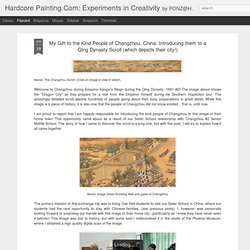
Welcome to Changzhou during Emperor Kangxi's Reign during the Qing Dynasty, 1691 AD! The image above shows the "Dragon City" as they prepare for a visit from the Emperor himself during his Southern Inspection tour. The amazingly detailed scroll depicts hundreds of people going about their busy preparations in great detail. While this image is a piece of history, it is also one that the people of Changzhou did not know existed... that is, until now. The Mactaggart Art Collection > Record Details. David Hockney on perspective and looking. Claude Monet. Houses of Parliament series. Claude Monet painted a series of paintings of the Palace of Westminster, home of the British Parliament, during his stays in London between the years 1900-1905.
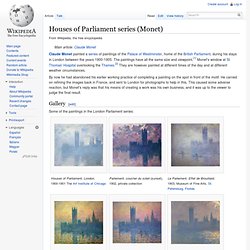
The paintings have all the same size and viewpoint,[1] Monet's window at St Thomas' Hospital overlooking the Thames.[2] They are however painted at different times of the day and at different weather circumstances. By now he had abandoned his earlier working practice of completing a painting on the spot in front of the motif. He carried on refining the images back in France, and sent to London for photographs to help in this. Houses of Parliament (1904) Houses of Parliament 360. Overview and History "When a man is tired of London, he is tired of life; for there is in London all that life can afford.

" - Samuel Johnson Do you know all the verses to the children's song, "London Bridge is falling down"? They will take you through the history of London so let's have a look, shall we? First we need a bridge, in order for it to fall down. Canaletto. The Grand Canal and the Church of the Salute, painted 1730.
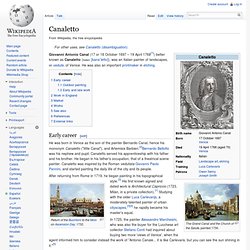
Giovanni Antonio Canal (17 or 18 October 1697 – 19 April 1768[1]) better known as Canaletto (Italian: [kanaˈletto]), was an Italian painter of landscapes, or vedute, of Venice. He was also an important printmaker in etching. Early career[edit] He was born in Venice as the son of the painter Bernardo Canal, hence his mononym Canaletto ("little Canal"), and Artemisia Barbieri.[2]Bernardo Bellotto was his nephew and pupil.
Canaletto served his apprenticeship with his father and his brother. Camera obscura. A drawing of a camera obscura. Bacino di San Marco (1738-1740) Bacino di San Marco 360. Overview and History Do you know why you never like to get out of the bathtub?

It's because you wish you were in Venice, that's why. Take one hundred and eighteen salt-marsh islands in the northern Adriatic. Combine them with Roman refugees and a liberal stinking of Visigoth invaders. Shake until well-mixed. Venice is divided into six districts called "Sistieri" in Italian; that word will come in handy when you're floating hither and yon. Beyond these, there's Lido and Mestre.
Westminster Bridge (1746) Jan van Eyck. Signature of Jan van Eyck Jan van Eyck (or Johannes de Eyck) (Dutch: [ˈjɑn vɑn ˈɛjk]; before c. 1390 – before c. 9 July 1441) was a Flemish painter active in Bruges and is generally considered one of the most significant Northern European painters of the 15th century.
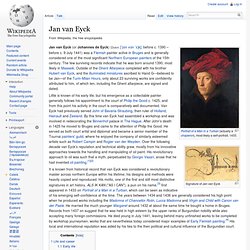
The few surviving records indicate that he was born around 1390, most likely in Maaseik. Outside of the Ghent Altarpiece completed with his brother Hubert van Eyck, and the illuminated miniatures ascribed to Hand G—believed to be Jan—of the Turin-Milan Hours, only about 23 surviving works are confidently attributed to him, of which ten, including the Ghent altarpiece, are signed and dated. Little is known of his early life, but his emergence as a collectable painter generally follows his appointment to the court of Philip the Good c. 1425, and from this point his activity in the court is comparatively well documented. Van Eyck had previously served John of Bavaria-Straubing, then ruler of Holland, Hainault and Zeeland. Retrato Matrimonio Arnolfini (1434) Claude Lorrain. Claude Lorrain (French: [klod lɔ.ʁɛ̃]; born Claude Gellée, [ʒəle], dit le Lorrain; traditionally just Claude in English; c. 1600 – 23 November 1682) was a French painter, draughtsman and engraver of the Baroque era.
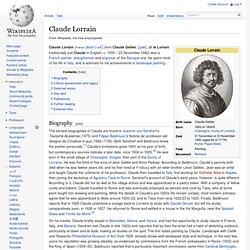
He spent most of his life in Italy, and is admired for his achievements in landscape painting. Biography[edit] Claude glass. Painting by Claude Lorrain (1655-1660) shows the gradation of tone that artists hoped to emulate with the help of a Claude glass.

A Claude glass (or black mirror) is a small mirror, slightly convex in shape, with its surface tinted a dark colour. Bound up like a pocket-book or in a carrying case, Claude glasses were used by artists, travelers and connoisseurs of landscape and landscape painting. Facebook y el "Espejo Negro" I have been thinking through ideas on this blog for my dissertation project about how we document ourselves on social media.

I recently posted some thoughts on rethinking privacy and publicity and I posted an earlier long essay on the rise of faux-vintage Hipstamatic and Instagram photos. There, I discussed the “camera eye” as a metaphor for how we are being trained to view our present as always its potential documentation in the form of a tweet, photo, status update, etc. (what I call “documentary vision”). The photographer knows well that after taking many pictures one’s eye becomes like the viewfinder: always viewing the world through the logic of the camera mechanism via framing, lighting, depth of field, focus, movement and so on.
Jean Auguste Dominique Ingres. Jean-Auguste-Dominique Ingres (French: [ʒɑnoɡyst dɔminik ɛ̃ɡʁ]; 29 August 1780 – 14 January 1867) was a French Neoclassical painter. Although he considered himself to be a painter of history in the tradition of Nicolas Poussin and Jacques-Louis David, by the end of his life it was Ingres's portraits, both painted and drawn, that were recognized as his greatest legacy. Early years[edit] Ingres was born in Montauban, Tarn-et-Garonne, France, the first of seven children (five of whom survived infancy) of Jean-Marie-Joseph Ingres (1755–1814) and his wife Anne Moulet (1758–1817). In 1791, Joseph Ingres took his son to Toulouse, where the young Jean-Auguste-Dominique was enrolled in the Académie Royale de Peinture, Sculpture et Architecture.
There he studied under the sculptor Jean-Pierre Vigan, the landscape painter Jean Briant, and the neoclassical painter Guillaume-Joseph Roques. In Paris[edit] The Envoys of Agammemnon, 1801, oil on canvas, École des Beaux Arts, Paris. Camera lucida. A camera lucida is an optical device used as a drawing aid by artists. The camera lucida performs an optical superimposition of the subject being viewed upon the surface upon which the artist is drawing. The artist sees both scene and drawing surface simultaneously, as in a photographic double exposure. This allows the artist to duplicate key points of the scene on the drawing surface, thus aiding in the accurate rendering of perspective.
Napoleon en su trono imperial (1806)